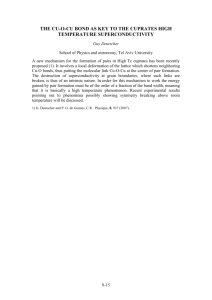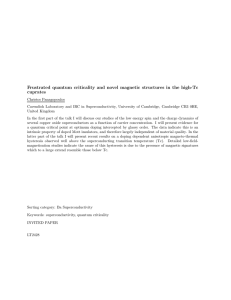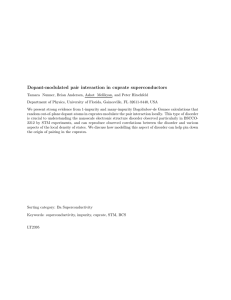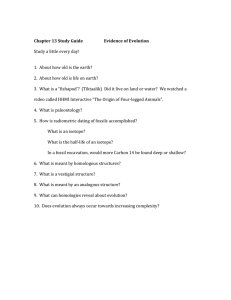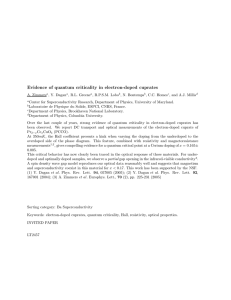Unified picture of the oxygen isotope effect in cuprate superconductors
advertisement
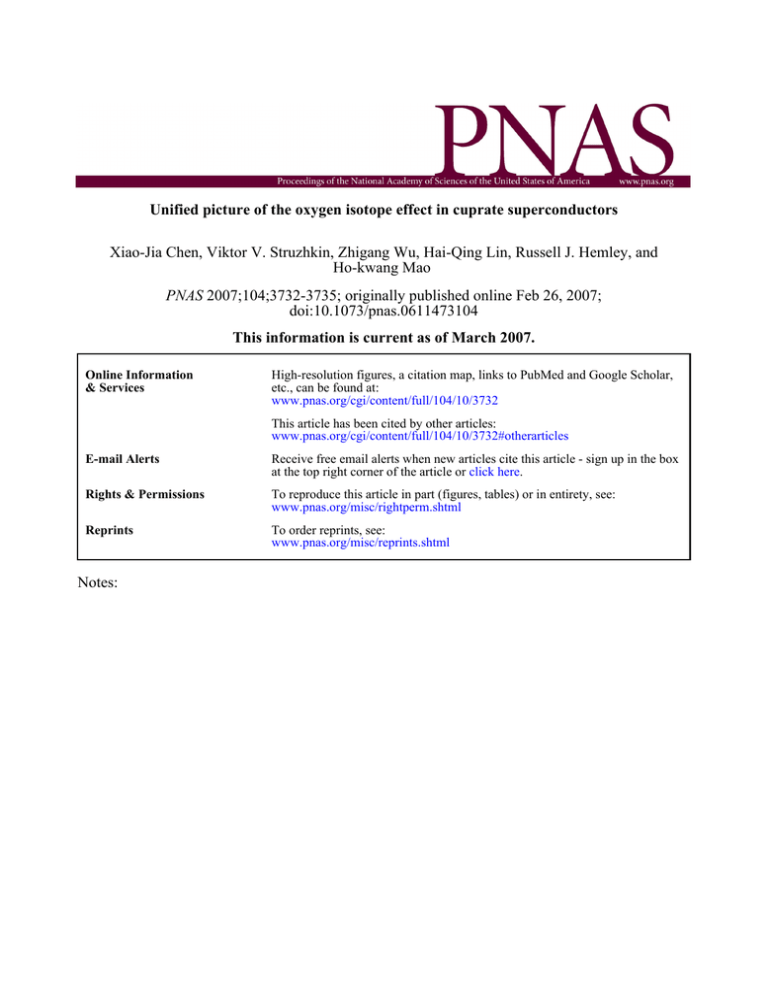
Unified picture of the oxygen isotope effect in cuprate superconductors Xiao-Jia Chen, Viktor V. Struzhkin, Zhigang Wu, Hai-Qing Lin, Russell J. Hemley, and Ho-kwang Mao PNAS 2007;104;3732-3735; originally published online Feb 26, 2007; doi:10.1073/pnas.0611473104 This information is current as of March 2007. Online Information & Services High-resolution figures, a citation map, links to PubMed and Google Scholar, etc., can be found at: www.pnas.org/cgi/content/full/104/10/3732 This article has been cited by other articles: www.pnas.org/cgi/content/full/104/10/3732#otherarticles E-mail Alerts Receive free email alerts when new articles cite this article - sign up in the box at the top right corner of the article or click here. Rights & Permissions To reproduce this article in part (figures, tables) or in entirety, see: www.pnas.org/misc/rightperm.shtml Reprints To order reprints, see: www.pnas.org/misc/reprints.shtml Notes: Unified picture of the oxygen isotope effect in cuprate superconductors Xiao-Jia Chen*‡§, Viktor V. Struzhkin*, Zhigang Wu*, Hai-Qing Lin¶, Russell J. Hemley*, and Ho-kwang Mao* *Geophysical Laboratory, Carnegie Institution of Washington, Washington, DC 20015; ‡Department of Applied Physics, South China University of Technology, Guangzhou 510641, China; and ¶Department of Physics, The Chinese University of Hong Kong, Hong Kong, China Contributed by Ho-kwang Mao, January 2, 2007 (sent for review November 1, 2006) High-temperature superconductivity in cuprates was discovered almost exactly 20 years ago, but a satisfactory theoretical explanation for this phenomenon is still lacking. The isotope effect has played an important role in establishing electron–phonon interaction as the dominant interaction in conventional superconductors. Here we present a unified picture of the oxygen isotope effect in cuprate superconductors based on a phonon-mediated d-wave pairing model within the Bardeen–Cooper–Schrieffer theory. We show that this model accounts for the magnitude of the isotope exponent as functions of the doping level as well as the variation between different cuprate superconductors. The isotope effect on the superconducting transition is also found to resemble the effect of pressure on the transition. These results indicate that the role of phonons should not be overlooked for explaining the superconductivity in cuprates. electron–phonon interaction 兩 high-temperature superconductivity 兩 pressure effect U nderstanding the high-temperature superconductivity in cuprate superconductors is at the heart of current research in solid-state physics. The isotope effect is an important experimental probe in revealing the underlying pairing mechanism of superconductivity. Early measurements (1) of the isotope effect on the superconducting transition temperature, Tc, provided key experimental evidence for phonon-mediated pairing and supported strongly the Bardeen–Cooper–Schrieffer (BCS) theory of superconductivity in conventional materials. When hightemperature superconductivity was discovered in copper oxides, the oxygen isotope exponents, defined by ␣ ' ⫺dlnTc/dlnM, with M being the isotopic mass, were promptly measured. The initial finding of the small value of ␣ in La1.85Sr0.15CuO4 (2, 3) and near zero value in YBa2Cu3O7⫺␦ (␦ ⬃ 0) (4–6) was taken to be convincing evidence against electron–phonon interaction as the dominant mechanism in these materials. However, later experiments have revealed a much richer and more complex situation (7). There is a striking variation of ␣ with doping level in a given cuprate material (8–11). Meanwhile, ␣ also varies among various compounds of different cuprate families (7, 12). Interestingly, ␣ is a remarkably monotonic function of the number of CuO2 layers in a way opposite to Tc in optimally doped compounds (12). Such elaborate isotope effects strongly suggest that one should include phonons in the theory of high-Tc superconductivity. Studies of neutron scattering (13), angleresolved photoemission spectroscopy (14, 15), and scanning transmission electron microscopy (16) provide further evidence for phonons being an important player in the basic physics of high-Tc superconductivity. Compared with isotope substitution, pressure has been realized not only to be another effective way to change Tc for a superconductor (17) but also to yield information on the interaction causing the superconductivity. So far, the record high Tc of 164 K was achieved under high pressure in HgBa2Ca2Cu3O8⫹␦ (18). Observing how the pressure influences the individual parameters of the lattice in the normal and superconducting state of a single sample allows a clean quantitative test of the 3732–3735 兩 PNAS 兩 March 6, 2007 兩 vol. 104 兩 no. 10 validity of theoretical models. In early 1964, Olsen et al. (19) showed that there is a correlation between the pressure coefficient of the effective interaction and the isotope effect in conventional metal superconductors. For high-Tc materials YBa2Cu3O7⫺␦, Franck and Lawrie (20) found a similar doping dependence for both the copper isotopic exponent and pressure coefficient of Tc, dlnTc/dP. These findings directly point to the equivalent importance of the pressure and isotope effects on superconductivity. Because many materials, among them 23 elements (17) and even spin-ladder cuprate (21), become superconductors only under sufficiently high pressure, measurements of the isotope effect in these materials must be performed under high pressure. Meanwhile, Crespi and Cohen (22) proposed that cuprates under high pressure are a hopeful candidate for attaining negative values for ␣, which would provide support to an anharmonic model for high-Tc superconductivity. Until now, there is little information regarding how ␣ changes with pressure in high-Tc cuprates. Such investigations are highly desirable for elucidating the mechanism of high-Tc superconductivity. The purpose of this paper is to offer an interpretation for the elaborate oxygen isotope effect in cuprate superconductors based on a phonon-mediated d-wave BCS-like model. We find that the effective next-nearest-neighbor hopping dominates the variation of ␣ for the optimally doped cuprates. Based on the measurements of both Tc and Raman shift of the B1g phonon mode, we predict that the pressure dependence of ␣ for the optimally doped YBa2Cu3O7⫺␦ is similar to that of the pressure coefficient of Tc. A unified picture for the isotope effect in cuprates is given at ambient condition and under high pressure, which is supported by good agreements between theory and experiments. Results and Discussion We start directly from the mean-field Hamiltonian describing d-wave superconductivity: H ⫽ 冘 共k ⫺ 兲ck† ck ⫺ k 冘 共⌬kc†k1c†⫺k2 ⫹ h.c.兲, [1] k where k is the quasiparticle dispersion, is the chemical potential, and ck† is a quasiparticle creation operator. The gap parameter ⌬k ⫽ N⫺1 兺k⬘Vkk⬘ 具c⫺k⬘2ck⬘1典, where N is the number of sites. Considering that the interaction could be of the chargecoupled type mediated by phonons, we used d-wave pairing potential Vkk⬘ ⫽ Vg(k)g(k⬘); k ⫺ or k⬘ ⫺ ⬍ 0, where g(k) ⫽ cos kx ⫺ cos ky, V is the in-plane pairing interaction strength, and 0 is the cutoff of the phonon frequency. For phonon-mediated pairing, 0 is assumed to vary with the isotope Author contributions: X.-J.C., V.V.S., Z.W., H.-Q.L., R.J.H., and H.-k.M. performed research. The authors declare no conflict of interest. Abbreviation: BCS, Bardeen–Cooper–Schrieffer. §To whom correspondence should be addressed. E-mail: xjchen@ciw.edu. © 2007 by The National Academy of Sciences of the USA www.pnas.org兾cgi兾doi兾10.1073兾pnas.0611473104 Hg1201 Tl2201 Tl1201 La214 Bi2201 0.6 60 α TC (K) 80 0.4 40 0.2 20 0 0 0 0.5 nH (holes) 1 0 0.5 nH (holes) 1 Fig. 1. The theoretical results of both the superconducting transition temperature, Tc, and oxygen isotope exponent, ␣, versus the hole concentration nH in single CuO2-layer cuprate superconductors La2⫺xSrxCuO4 (La214), Bi2Sr2CuO6⫹␦ (Bi2201), TlBa2CuO5⫹␦ (Tl1201), Tl2Ba2CuO6⫹␦ (Tl2201), and HgBa2CuO4⫹␦ (Hg1201). mass, M, as M⫺1/2. The d-wave gap function has the typical form ⌬k ⫽ ⌬g(k), and the parameter ⌬ is determined by 1 ⫽ 1 N 冘 Vg2共k兲k共0 ⫺ 兩k ⫺ 兩兲, [2] k where k ⫽ (2Ek)⫺1tanh(Ek/2), with the quasiparticle spectrum Ek ⫽ 公(k ⫺ )2 ⫹ ⌬k2 in the d-wave state, and the step function (x) takes care of the condition k ⫺ or ⬘k ⫺ ⬍ 0. The Tc equation is then obtained by solving Eq. 2 with ⌬ ⫽ 0. Solving this self-consistently for a given yields Tc as a function of hole concentration. The validity of the d-wave BCS formalism in describing the superconducting state of cuprates has been supported by recent measurements of angle-resolved photoemission spectroscopy (23) and transport properties (24). Differentiating Eq. 2 with respect to both Tc and 0, one can express ␣ ⬅ (1/2)dlnTc/dln0 as 1 N ␣⫽ 1 N 冘 冘 冉 冊 冉 冊 0 ␦ (0 ⫺ 兩k ⫺ 兩) 2T c . 兩k ⫺ 兩 2 2 g (k)sech ( ⫺ 兩 ⫺ 兩) k 0 k 2T c k T c g2(k) tanh [3] Once knowing the cutoff frequency 0, dispersion k, and interaction V, one can obtain the Tc and ␣ behaviors based on Eqs. 2 and 3. We choose a typical 0 ⫽ 0.060 eV (13–16). For the dispersion, we use k ⫽ t⬘effcos kx cos ky ⫹ t⬙eff(cos 2kx ⫹ cos 2ky), with t⬘eff and t⬙eff being the effective next-nearest-neighbor and next-next-nearestneighbor hoppings, respectively. Such a dispersion can reproduce the bandwidth and Fermi-surface shape of many cuprate superconductors (25, 26). It has been shown (27) that the choice of teff ⫽ 0.032 eV and V ⫽ 0.03762 eV can reproduce the experimentally observed maximum value of the superconducting transition temperature, T max c , ranging from 30 to 97 K of various optimally doped monolayer cuprates when changing t⬘eff from ⫺0.032 to 0.0914 eV. To keep the consistency of the theory, we use the same t⬙eff and V values in the following calculations. The relative t⬘eff can be estifor an individual mated by using the experimentally observed T max c material. Fig. 1 shows the calculated Tc and ␣ as a function of hole concentration nH for some typical monolayer cuprates. As shown, Tc initially increases with increasing nH to a maximum around an optimal doping level nopt H and then decreases with further increasing nH. This parabolic relation between Tc and nH agrees well with experimental observations in general. The Chen et al. maximum in the Tc versus nH curves is shifted toward smaller nH values among these materials, in remarkable agreement with experiment. This behavior implies that the diluted optimal hole concentration is in favor of the higher value of the maximum Tc when a material is optimally doped. Because t⬘eff in dispersion is the only other parameter used in calculation, the different Tc behaviors of these materials should come from their electronic structure. This character provides an explicit interpretation for the role played by the ‘‘chemistry’’ in determining the maximum Tc via the effect on the electronic structure, as early suggested by Phillips (28, 29). The calculated ␣ exhibits many interesting features. The values of ␣ are always positive over the whole doping range for all studied monolayer materials. There exists a minimum ␣ at some doping level on the overdoped side, away from which one can find most large values of ␣. A significant increase in ␣ occurs when the sample is highly underdoped or highly overdoped. In low-Tc groups, such as La-, Bi-, and single-layer Tl-based cuprates, ␣ does not vary monotonically with doping and its value is relatively large at optimal doping. For high-Tc two-layer Tland Hg-based materials, ␣ is found to decrease monotonically with doping on the underdoped side, reaching a minimum on the overdoped side after passing through the optimal doping level, and then it is found to increase gradually when the material is highly overdoped. Such a difference is also believed to be a result of the electronic structure effect. Currently, La2⫺xSrxCuO4 is the only monolayer system whose doping dependence of ␣ is well known over the whole doping regime (2, 3, 9). Note that the experimentally observed ␣ behavior in this system can be reproduced by the present d-wave BCS-like model, except in the region near x ⫽ 0.125. The large ␣ value at this doping level is related to the appearance of the stripe order (30), which is beyond the present theoretical treatment. Considering that the dispersion relations used are derived from short distance antiferromagnetic correlations, our model is in reality a mixture of both electronic and phononic contributions. Therefore, a phonon-induced attraction combines with a hole dispersion modulated by antiferromagnetic correlations to contribute to pairing. Although the similar doping dependence of the isotope exponent can be reproduced within van Hove scenarios (31–33), the material-dependent dispersions considered here enable us to investigate the variation of the isotope effect among various cuprates. In Fig. 2, the t⬘eff dependence of both the maximum Tc and ␣ is plotted for optimally doped materials in the range of interest of t⬘eff. Clearly, t⬘eff dominates the maximum Tc behavior among various compounds, confirming previous theoretical interpretations (27, 34). The most significant observation is that ␣ is not negligible but rather varies with t⬘eff as well. For small t⬘eff values, the material also has a small value of the maximum Tc but a large value of ␣. As t⬘eff increases (leading to the increase of the maximum Tc), ␣ first sharply drops and then gradually decreases, reaching a minimum at around t⬘eff ⫽ 0.048 eV; further increase in t⬘eff leads to slightly increasing ␣. The theoretical calculations yield ␣ of 0.26 for the optimally doped La2⫺xSrxCuO4, which is consistent with the experiments (2, 3). Therefore, this model predicts that both the maximum Tc and ␣ in these optimally doped cuprates are in reality related to the modification of the electronic structure through the change of t⬘eff. The crucial role of t⬘eff has been proposed (35) to be associated to the Jahn-Teller active Q2-type mode. Our results imply that the coupling of the electronic degrees of freedom to the Jahn-Teller Q2-type mode is responsible for the material dependence of the isotope effect. According to our theoretical analysis, the optimally doped Tl2Ba2CuO6⫹␦ should have the smallest ␣ value compared with other monolayer compounds. Thus, experiments are desirable to answer whether the systematic evolution of ␣ among cuprates is correctly predicted here. PNAS 兩 March 6, 2007 兩 vol. 104 兩 no. 10 兩 3733 PHYSICS 0.8 100 120 Hg1201 100 α 20 0.04 t´eff (eV) 0.08 80 380 70 360 60 0 0.12 Fig. 2. The effective next-nearest-neighbor hopping t⬘eff dependence of both the oxygen isotope exponent, ␣, and the maximum value of the supercon, in various optimally doped monolayer ducting transition temperature, Tmax c cuprate superconductors. The corresponding t⬘eff value is marked on the top of the frame for La2⫺xSrxCuO4 (La214), Bi2Sr2CuO6⫹␦ (Bi2201), TlBa2CuO5⫹␦ (Tl1201), Tl2Ba2CuO6⫹␦ (Tl2201), and HgBa2CuO4⫹␦ (Hg1201). For YBa2Cu3O7⫺␦, assuming that the ␣ behavior is affected only negligibly by interlayer coupling, we can estimate the value of t⬘eff from Eq. 2 when taking Tmax ⫽ 92 K at the optimal doping. c Thus, we are able to calculate the changes in Tc and ␣ for this material by using Eqs. 2 and 3. Calculation results are shown in Fig. 3 together with experimental data for comparisons. As can be seen, all of the ␣ values are positive over the whole doping regime. The optimally doped material has the corresponding minimum ␣ of 3.5 ⫻ 10⫺3. An early study on YBa2Cu3O7 gives a value of ␣ of 0 ⫾ 0.02 (4). Another careful examination of five pairs of YBa2Cu3O7 samples (6) gives an oxygen isotope effect of ␣ ⫽ 0.017 ⫾ 0.006. The comparison between theory and experiments is excellent at the optimal doping level. As the material goes away from the optimal doping level, ␣ increases with decreasing Tc. By changing the oxygen content, Zech et al. (8) observed that ␣ remains rather small at Tc ⯝ 61 K and then increases for a further decrease of Tc down to ⬇53 K in YBa2Cu3O7⫺␦ (0.47 ⬎ ␦ ⬎ 0.01). The gradual increase of ␣ with the dramatic reduction of T c was reported in YBa2(Cu1⫺xZnx)3O7⫺␦ (7). As is clearly seen in Fig. 3, the 0.8 YBa2Cu3O7-δ 0.6 400 5 10 15 Pressure (GPa) 20 340 25 Fig. 4. Both the superconducting transition temperature, Tc, and Raman shift of the B1g phonon mode taken at 25 K as a function of pressure up to 22.3 GPa in the optimally doped YBa2Cu3O7⫺␦. theoretical curves cover most of these experimental data points (4–8), except the points at ⬇50 K, where a maximum of ␣ is believed to be associated with the chain oxygen ordering (20). It is apparent that the present theoretical model accounts for the observed isotope effects in this extensively studied high-Tc material as well. Therefore, it is natural to expect a nearly zero oxygen isotope effect in the optimally doped YBa2Cu3O7⫺␦ for a BCS-type electron-phonon interaction pairing. It is worth noting that the doping dependence of ␣ in YBa2Cu3O7⫺␦ resembles that of dlnTc/dP (36, 37), signaling a nice correlation between the isotope and pressure effects. We now show how the present d-wave BCS-like model can predict the high-pressure behavior of ␣. Just like the case at ambient conditions, the change of ␣ with pressure is assumed to be through the changes of both Tc and 0 and is then expressed by ␣(P) ⫽ ␣[Tc(P), 0(P)]. For the cutoff phonon frequency 0(P), we take the pressure dependence of the frequency B1g of the B1g Cu–O bond-buckling phonon, which has been ascribed as a bosonic mode inf luencing high-Tc superconductivity (14). The information on B1g(P) can be obtained by high-pressure Raman scattering measurements. We thus have 0(P) ⫽ [0(0)/B1g(0)]B1g(P). The ␣(P) behavior can be derived from Eq. 3 based on the Tc(P) and B1g(P) determinations. We choose optimally doped YBa2Cu3O7⫺␦ as an example. Raman spectra in the y(xx)y (A1g ⫹ B1g) geometry were taken at 25 K and at different pressures up to 22.3 GPa. The most pronounced spectral change under pressure is a significant enhancement of the B1g phonon mode near 300 0.01 0.004 0.4 α YBa2Cu3O7-δ 0 α -0.01 -0.02 20 40 60 80 100 0.002 -1 0 0 TC (K) Fig. 3. Oxygen isotope exponent, ␣, versus the superconducting transition temperature, Tc, in YBa2Cu3O7⫺␦. The solid line represents the theory, with the lower and upper curves representing the underdoped and overdoped sides, respectively. The open diamond, filled circle, filled squares, and open triangles represent the experiments from refs. 4, 6, 7, and 8, respectively. A maximum of ␣ at Tc ⬇ 50 K is believed to be associated with the chain oxygen ordering. 3734 兩 www.pnas.org兾cgi兾doi兾10.1073兾pnas.0611473104 dlnTC/dP (GPa ) 0.003 0.2 -1 0 90 Raman shift (cm ) 40 (K) 0.1 max 60 TC 80 0.2 0 420 YBa2Cu3O7-δ 0.3 -0.04 100 TC (K) Tl2201 Tl1201 Bi2201 La214 0.4 -0.03 0.001 0 10 2 20 Pressure (GPa) -0.04 30 Fig. 5. Pressure dependence of both the oxygen isotope exponent ␣ and pressure coefficient of Tc, dlnTc/dP, in the optimally doped YBa2Cu3O7⫺␦. Chen et al. cm⫺1. Fig. 4 shows the measured Tc(P) and Raman shift B1g(P) of B1g phonon mode obtained by fitting the Raman data in terms of a Green’s function approach (38). Note that the measured Tc(P) behavior of this material is consistent with other independent measurements (39, 40). In Fig. 5 we present the calculated ␣ as a function of pressure up to 25 GPa in the optimally doped YBa2Cu3O7⫺␦ together with dlnTc/dP for comparison. As pressure is increased, ␣ slightly decreases in a manner similar to dlnTc/dP, as expected from an anharmonic model (22), but ␣ remains small and positive within the pressure regime studied. Our calculations allow the prediction of isotope effect changes under pressure in cuprate superconductors. The similarity of the isotope effect and the pressure effect both at ambient condition and under high pressure indicates that both effects are playing an equivalent role in shedding important light on high-Tc superconductivity in cuprates. There has been no report of isotope measurements under high pressure in cuprates so far. The prediction made here for ␣(P) awaits further experimental studies. We should emphasize that the present theoretical investigation is based on a d-wave model. However, we find that the d-wave character is not critical to the results obtained and conclusions drawn. An s-wave model can also give the similar general trend of ␣ as functions of doping and pressure. We also would like to mention that the strong correlation effect is not directly included in our theoretical treatment, rather entering our model through the hole dispersion. Although the physics in the low-doping regime would be dominated by antiferromagnetic correlations, electron– phonon coupling is expected to be more important in the optimal and overdoped regime. The present theoretical model bears nicely the experimentally observed generic phase diagram between the Tc and doping level. Therefore, we believe that all our results and conclusions are physically valid over a wide range of doping regimes. We thank O. K. Andersen, V. H. Crespi, T. Cuk, A. F. Goncharov, A. Lanzara, J. C. Phillips, J. S. Schilling, S. Y. Zhou, and J. X. Zhu for stimulating discussions. This work was supported by the Office of Basic Energy Science and National Nuclear Security Administration of the U.S. Department of Energy. H.Q.L. was supported by the Hong Kong Research Grants Council. 1. Maxwell E (1995) Phys Rev 78:477. 2. Batlogg B, Kourouklis G, Weber W, Cava RJ, Jayaraman A, White AE, Short KT, Rupp LW, Rietman EA (1987) Phys Rev Lett 59:912–914. 3. Faltens TA, Ham WK, Keller SW, Leary KJ, Michaels JN, Stacy AM, zur Loye HC, Morris DE, Barbee TW, III, Bourne LC, et al. (1987) Phys Rev Lett 59:915–918. 4. Batlogg B, Cava RJ, Jayaraman, A., van Dover RB, Kourouklis GA, Sunshine S, Murphy DW, Rupp LW, Chen HS, White A, et al. (1987) Phys Rev Lett 58:2333–2336. 5. Bourne LC, Crommie MF, Zettl A, zur Loye HC, Keller SW, Leary KL, Stacy AM, Chang KJ, Cohen ML, Morris DE (1987) Phys Rev Lett 58:2337–2339. 6. Benitez EL, Lin JJ, Poon SJ, Farneth WE, Crawford MK, McCarron EM (1988) Phys Rev B 38:5025–5027. 7. Franck JP (1994) in Physical Properties of High Temp Superconductors IV, ed Ginzberg DM (World Sci, Singapore), pp 189–293. 8. Zech D, Conder K, Keller H, Kaldis E, Müller KA (1996) Physica B 219&220:136–138. 9. Crawford MK, Kunchur MN, Farneth WE, McCarron EM, III, Poon SJ (1990) Phys Rev B 41:282–287. 10. Bornemann HJ, Morris DE, Liu HB, Narwankar PK (1992) Physica C 191:211–218. 11. Pringle DJ, Williams GVM, Tallon JL (2000) Phys Rev B 62:12527–12533. 12. Zhao GM, Kirtikar V, Morris DE (2001) Phys Rev B 63:220506. 13. McQueeney RJ, Sarrao JL, Pagliuso PG, Stephens PW, Osborn R (2001) Phys Rev Lett 87:077001. 14. Cuk T, Baumberger F, Lu DH, Ingle N, Zhou XJ, Eisaki H, Kaneko N, Hussain Z, Devereaux TP, Nagaosa N, et al. (2004) Phys Rev Lett 93:117003. 15. Gweon GH, Sasagawa T, Zhou SY, Graf J, Takagi H, Lee DH, Lanzara A (2004) Nature 430:187–190. 16. Lee J, Fujita K, McElroy K, Slezak JA, Wang M, Aiura Y, Bando H, Ishikado M, Masui T, Zhu JX, et al. (2006) Nature 442:546–550. 17. Schilling JS (2006) in High-Temperature Superconductivity: A Treatise on Theory and Applications, ed Schrieffer JR (Springer, Berlin). 18. Gao L, Xue YY, Chen F, Xiong Q, Meng RL, Ramirez D, Chu CW, Eggert JH, Mao HK (1994) Phys Rev B 50:4260–4263. 19. Olsen JL, Bucher E, Levy M, Muller J, Corenzwit E, Geballe T (1964) Rev Mod Phys 36:168–170. 20. Franck JP, Lawrie DD (1996) J Low Temp Phys 105:801–806. 21. Uehara M, Nagata T, Akimitsu J, Takahashi, H., Môri N, Kinoshita K (1996) J Phys Soc Jpn 65:2764–2767. 22. Crespi VH, Cohen ML (1993) Phys Rev B 48:398–406. 23. Matsui H, Sato T, Takahashi T, Wang SC, Yang HB, Ding H, Fujii T, Watanabe T, Matsuda A (2003) Phys Rev Lett 90:217002. 24. Latyshev, Yu I, Yamashita T, Bulaevskii LN, Graf MJ, Balatsky AV, Maley MP (1999) Phys Rev Lett 82:5345–5348. 25. Dagotto E, Nazarenko A, Moreo A (1995) Phys Rev Lett 74:310–313. 26. Belinicher VI, Chernyshev AL, Shubin VA (1996) Phys Rev B 53:335–342; 54:14914–14917. 27. Chen XJ, Lin HQ (2004) Phys Rev B 69:104518. 28. Phillips JC (1987) Phys Rev B 36:861–863. 29. Phillips JC (1994) Phys Rev Lett 72:3863–3866. 30. Emery VJ, Kivelson SA, Lin HQ (1990) Phys Rev Lett 64:475–478. 31. Tsuei CC, Newns DM, Chi CC, Pattnaik PC (1990) Phys Rev Lett 65: 2724 –2727. 32. Nazarenko A, Dagotto E (1996) Phys Rev B 53:R2987–R2990. 33. Xing DY, Liu M, Wang YG, Dong JM (1999) Phys Rev B 60:9775–9781. 34. Pavarini E, Dasgupta I, Saha-Dasgupta T, Jepsen O, Andersen OK (2001) Phys Rev Lett 87:047003. 35. Bussmann-Holder A, Keller H (2005) Eur Phys J B 44:487–490. 36. Almasan CC, Han SH, Lee BW, Paulius LM, Maple MB, Veal BW, Downey JW, Paulikas AP, Fisk Z, Schirber JE (1992) Phys Rev Lett 69:680–683. 37. Chen XJ, Lin HQ, Gong CD (2000) Phys Rev Lett 85:2180–2183. 38. Goncharov AF, and Struzhkin VV (2003) J Raman Spectrosc 34: 532–548. 39. Tissen VG, and Nefedova MV (1990) Sverkhprovodn Fiz Khim Tekh 3:999– 1002. 40. Klotz S, Reith W, Schilling JS (1991) Physica C 172:423–426. 41. Timofeev YA, Struzhkin VV, Hemley RJ, Mao HK, Gregoryanz EA (2002) Rev Sci Instr 73:371–377. Chen et al. Conclusions We have obtained a clear picture of the oxygen isotope effects in high-temperature superconductors based on a phenomenological phonon-mediated BCS-like model. We demonstrate that the variation of ␣ among various optimally doped cuprates is controlled by the effective next-nearest-neighbor hopping. The obtained oxygen isotope effect resembles the pressure effect both at ambient conditions and under high pressure. The good agreement between theory and experiment strongly suggests that the role of phonons should be taken into account for explaining the high-temperature superconducting properties in cuprates. PNAS 兩 March 6, 2007 兩 vol. 104 兩 no. 10 兩 3735 PHYSICS Materials and Methods Samples of single crystal YBa2Cu3O7⫺␦ were grown by a self-flux technique. We performed the measurements of Tc under high pressures by using a highly sensitive magnetic susceptibility technique with diamond anvil cells (41). The technique is based on the quenching of the superconductivity and suppression of the Meissner effect in the superconducting sample by an external magnetic field. The magnetic susceptibility of the metallic parts of the high-pressure cells is essentially independent of the external field. Therefore, the magnetic field applied to the sample inserted in the diamond cell mainly affects the change of the signal coming from the sample. Our high pressure Raman system and experiments are detailed in ref. 38. We have used synthetic ultrapure anvils to reduce diamond fluorescence. Samples were loaded into diamond anvil cells with helium as a pressure medium, and pressure was determined by using the ruby fluorescence technique.
